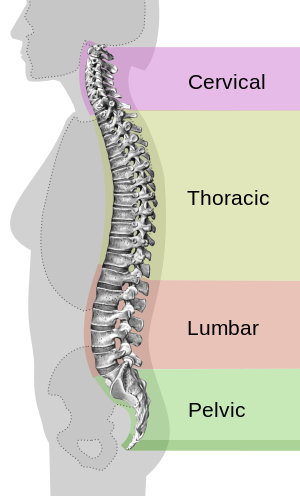Neutral spine
| Neutral spine | |
|---|---|
 |
|
| Different regions (curvatures) of the vertebral column | |
| Classification and external resources | |
| Specialty | rheumatology |
| ICD-10 | M54 |
| ICD-9-CM | 724.5 |
| DiseasesDB | 15544 |
| MeSH | D001416 |
A neutral spine or good posture refers to the "three natural curves [that] are present in a healthy spine." Looking directly at the front or back of the body, the 33 vertebrae in the spinal column should appear completely vertical. From a side view, the cervical (neck) region of the spine (C1-C7) is bent inward, the thoracic (upper back) region (T1-T12) bends outward, and the lumbar (lower back) region (L1-L5) bends inward. The sacrum (tailbone area) (S1-S5 fused) and coccyx (on average 4 fused) rest between the pelvic bones. A neutral pelvis indicates the anterior superior iliac spines and pubic symphysis fall in the same vertical line.
The word posture comes from the Latin verb ponere, which means "to put or place." The general concept of human posture refers to the "carriage of the body as a whole, the attitude of the body, or the position of the limbs (the arms and legs)."
Webster's New World Medical Dictionary defines neutral posture as the stance that is attained "when the joints are not bent and the spine is aligned and not twisted. Neutral posture has given rise to the idea of achieving “ideal posture.” Ideal posture indicates proper alignment of the body’s segments such that the least amount of energy is required to maintain a desired position. The benefit of achieving this ideal position would be that the least amount of stress is placed on the body’s tissues. In this position, a person is able to completely and optimally attain balance and proportion of his or her body mass and framework, based on his or her physical limitations. Good posture optimizes breathing and affects the circulation of bodily fluids.
In medicine and occupations concerned with physical fitness, the concept of good posture is referred to as "neutral spine. In this context, proper posture or "neutral spine," is the proper alignment of the body between postural extremes. Deviations from neutral alignment are identified as excessive curvature or reduction in curvature. Rarely do these deviations in curvature occur in only one plane; however, they are typically referred to in this manner. In the anterior/posterior view, deviation from vertical results in abnormal lateral curvature of the spine called scoliosis. In the sagittal view, excessive curvature in the cervical region is cervical lordosis, in the thoracic region thoracic kyphosis, and in the lumbar region lumbar lordosis. Reduction in curvature is typically termed flat back if present in the thoracic region and lumbar kyphosis if present in the lumbar region. In posture analysis, the spine is compared to a plumb line to detect the aforementioned abnormalities. From the anterior/posterior view this plumb line should run vertically down the midline of the body dividing it symmetrically into right and left halves indicating even weight distribution on left and right sides. From the sagittal view the plumb line should bisect the ear, odontoid process of C2, the cervical vertebral bodies, the center of the glenohumeral joint, the lumbar vertebral bodies, the center of the acetabulum, just posterior to the patella, and through the tarsals of the feet. This sagittal line of reference theoretically indicates even distribution of weight between the front and the back of the body.
...
Wikipedia
